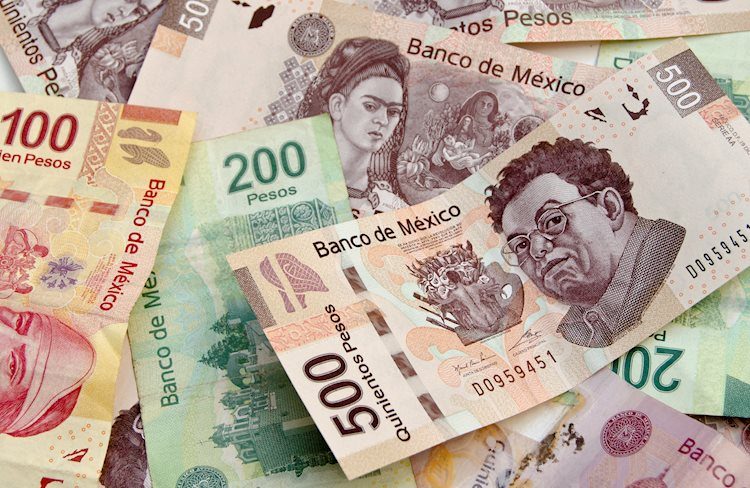- Mexican Peso halts two-day losing streak against USD, with USD/MXN trading down on the day.
- Mexico’s inflation data was mixed ahead of the release of Banxico’s last meeting minutes.
- USD/MXN to remain trading range-bound amid low volume due to the Thanksgiving holiday in the US.
Mexican Peso (MXN) snaps two days of losses against the US Dollar (USD), though it remains sideways amid thin liquidity trading as markets remain closed in observance of the Thanksgiving holiday in the United States (US). Economic data from Mexico shows the disinflation process found a bump, despite comments from the Bank of Mexico (Banxico) officials, suggesting they could ease monetary policy in 2024. The USD/MXN trades with losses of 0.12% on the day, though it remains near the weekly highs.
The economic docket in Mexico witnessed an uptick in headline mid-November inflation in monthly and annually based figures, while the core, which excludes volatile items, was below estimates and the prior’s reading. The rise in inflation could be attributed to the government’s end of the power summer subsidies in some cities. Ahead of the week, the calendar will feature the release of Banxico’s last meeting minutes, which is expected to shed some light on the status of the economy.
Daily digest movers: Mexican Peso virtually unchanged due to the US holiday
- The Mexican Consumer Price Index (CPI) for mid-November annually increased by 4.32%, exceeding estimates of 4.31%.
- Core CPI in Mexico decelerated compared to previous data and slowed to 5.31%, below forecasts of 5.33%.
- INEGI estimates the economy shrank 0.1% MoM in October, though annually based, it expanded by 2.9%, according to the agency Timely Indicator of Economic Activity (IOAE).
- A Citibanamex poll suggests that 25 of 32 economists polled expect Banxico’s first rate cut in the first half of 2024.
- The poll shows “a great dispersion” for interest rates next year, between 8.0% and 10.25%, revealed Citibanamex.
- The same survey revealed that economists foresee headline annual inflation at 4% and core at 4.06%, both readings for the next year, while the USD/MXN exchange rate is seen at 19.00, up from 18.95, toward the end of 2024
- Data published last week showed prices paid by consumers and producers in the US dipped, increasing investors’ speculations that the Fed’s tightening cycle has ended.
- The swap market suggests traders expect 100 basis points of rate cuts by the Fed in 2024.
- Banxico revised its inflation projections from 3.50% to 3.87% for 2024, which remains above the central bank’s 3.00% target (plus or minus 1%).
Technical Analysis: Mexican Peso stays firm, though USD/MXN trades range-bound on thin liquidity conditions
The USD/MXN remains bearishly biased, as the pair remains trading well below the downward slope of the 100, 20, 200, and 50-day Simple Moving Averages (SMAs). Even though it formed a ‘tweezers bottom’ chart pattern, price action was capped below the November 21 high of 17.26, which so far weighed on the pair, which dipped to a two-day low of 17.14.
For a bearish continuation, the exotic pair must get toward the 17.00 figure, so sellers could threaten to drag prices toward the year-to-date (YTD) low of 16.62. On the other hand, if buyers reclaim the current week’s high of 17.26, that could open the door to testing the 100-day SMA.
Mexican Peso FAQs
The Mexican Peso (MXN) is the most traded currency among its Latin American peers. Its value is broadly determined by the performance of the Mexican economy, the country’s central bank’s policy, the amount of foreign investment in the country and even the levels of remittances sent by Mexicans who live abroad, particularly in the United States. Geopolitical trends can also move MXN: for example, the process of nearshoring – or the decision by some firms to relocate manufacturing capacity and supply chains closer to their home countries – is also seen as a catalyst for the Mexican currency as the country is considered a key manufacturing hub in the American continent. Another catalyst for MXN is Oil prices as Mexico is a key exporter of the commodity.
The main objective of Mexico’s central bank, also known as Banxico, is to maintain inflation at low and stable levels (at or close to its target of 3%, the midpoint in a tolerance band of between 2% and 4%). To this end, the bank sets an appropriate level of interest rates. When inflation is too high, Banxico will attempt to tame it by raising interest rates, making it more expensive for households and businesses to borrow money, thus cooling demand and the overall economy. Higher interest rates are generally positive for the Mexican Peso (MXN) as they lead to higher yields, making the country a more attractive place for investors. On the contrary, lower interest rates tend to weaken MXN.
Macroeconomic data releases are key to assess the state of the economy and can have an impact on the Mexican Peso (MXN) valuation. A strong Mexican economy, based on high economic growth, low unemployment and high confidence is good for MXN. Not only does it attract more foreign investment but it may encourage the Bank of Mexico (Banxico) to increase interest rates, particularly if this strength comes together with elevated inflation. However, if economic data is weak, MXN is likely to depreciate.
As an emerging-market currency, the Mexican Peso (MXN) tends to strive during risk-on periods, or when investors perceive that broader market risks are low and thus are eager to engage with investments that carry a higher risk. Conversely, MXN tends to weaken at times of market turbulence or economic uncertainty as investors tend to sell higher-risk assets and flee to the more-stable safe havens.
Read the full article here

